On April 7th I participated in the British Society for Literature and Science annual conference at Oxford Brookes University, with a paper entitled Out of the Comfort Zone. Dan Brown’s Origin as a standpoint on literature and science. What follows is the text of my talk.
In his last novel Origin, the bestselling author Dan Brown imagines that an acclaimed scientist and futurist, whose name is Edmond Kirsch, is about to announce a disrupting scientific discovery on the origin of life. Right before the spectacular presentation of his research, Kirsch tells his long-time friend and old-fashioned humanities scholar Robert Langdon, the main character of several Dan Brown’s novels, including the groundbreaking Da Vinci Code: «Tonight is all about pushing people outside their comfort zones».
Similarly, the novel itself can push literary criticism and the humanities outside the comfort zone of their acknowledged interpretative practices, usually at unease with the analysis of such cultural objects, socially meaningful but aesthetically controversial. For sure, it pushes me out of the comfort zone of my research on Italian Studies, unfamiliar with popular and science fiction. Still, I decided to take-up Dan Brown’s challenge and displaced myself to look at the relationships between literature and science from the standpoint of a popular bestseller novel. To learn from the bestseller, where outstanding scientific discoveries are both simplified and overstated to fit into an appealing narrative framework, how literature and the humanities could address the major challenges entailed in the current scientific debate.
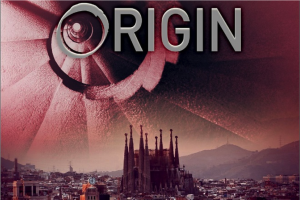
To assume the point of view of the bestseller, I’ll undergo three significant displacements in this presentation. First, from the standpoint of the bestseller, I’ll look at how Western society is shaken by a massive clash between the traditional, humanities-driven organisation of culture and the disruptions triggered by scientific knowledge and technology. Second, from the standpoint of the bestseller, I’ll look at how correlations can be established between cultural forms and biological processes, history of arts and history of evolution. Indeed, though in a simplified fashion the novel suggests that hypotheses can be made about the biological underpinnings of creativity and the evolutionary significance of art. Third, from the standpoint of the bestseller, I’ll look at how literature can embody scientific insights and become a channel of popularisation and cultural elaboration of scientific research and discoveries.
First displacement. As it is often the case with popular culture, Origin unveils conflicts and tensions harboured into the unconscious of collective imagination. And while the novel seems to reproduce Dan Brown’s usual conflict between enlightened science and regressive religion, I argue that a deeper and more complex confrontation is represented this time. That is, the tearing battle of past and future, tradition and innovation. Brown represents the ancient, weary civilisation shaped by humanistic culture challenged by an utterly new civilisation, tech-driven and shaped by science.
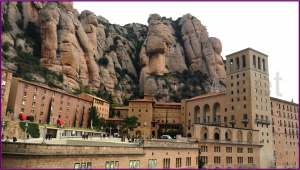
The novel begins in the monastery of Montserrat in Catalunya, where Edmond Kirsch meets the leaders of the most important world religions to anticipate its discovery. The old library of Montserrat is the shrine of ancient culture, and its rooms are burdened by the weight of heavy and dusty old books. The same image of the past cultural weight will be displayed in Edmond’s presentation of his research:
The screen now showed a photo of a dusty library shelf, where leather-bound tomes on ancient mythology languished in the dark beside books on nature worship, Baal, Inana, Osiris, and innumerable early theologies.
Montserrat’s library is opposed in the first place to the Bilbao Guggenheim Museum, where Edmond’s presentation is showcased, and which is the architectural translation of post-humanism. «This building doesn’t just break the rules […] It ignores them completely», observes Langdon accessing the space. Langdon here represents the astonished witness of traditional culture, ironically defining himself a classicist, who does better with Da Vinci than with de Kooning. A statement that is, of course, a winking to the reader of Dan Brown’s best-known novel, the Da Vinci Code. The super-smart professor, and consequently the reader who is familiar with him, are both the repositories of a type of knowledge which is going to be radically challenged.
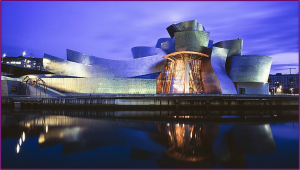
Montserrat’s library is also opposed to the library Edmond Kirsch builds in Gaudì’s Casa Milà in Barcelona, the headquarter he chooses to elaborate his discovery.
Edmond had transformed a wide section of curved hallway into a stunning library by building shelves between the vertical supports of Gaudì’s vaults.
This particular library, endowed with the most updated scientific knowledge, along with inspirational artistic books, adheres to Gaudi’s architecture, which in its turn follows the rule of nature and biology.
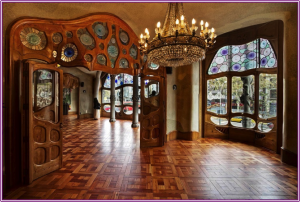
The architectonical confrontation of past and future is also represented in the last section of the novel. To release Edmond Kirsch’s discovery, of course obstructed and delayed by obscure powers, Langdon ends up in the Barcelona Supercomputing Centre, that is, a high-tech lab built inside a decommissioned Catholic church. The superimposition of a church and a lab, the supercomputer invading the space of God, is a rather bold representation of two ideas of knowledge fighting each other.
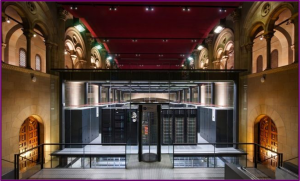
A similar dualism of what is old and what is new is reproduced inside the lab, where the actually existing Supercomputer Mare Nostrum is represented as an old machine: huge, heavily cabled, noisy. On the contrary, on the second floor of the lab is displayed Edmond’s quantic computer E-Wave, «a massive metallic blue-gray cube – ten feet square – with no wires, no blinking lights, and nothing about it to suggest it could possibly be a cutting-edge computer». E-Wave is also defined as a «metallic monolith», with a clear echo of the mysterious black monolith from 2001 Space Odyssey, a movie in which a series of evolutionary leaps are represented.
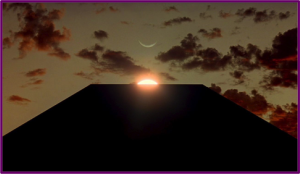
The combination of Mare Nostrum and E-Wave is the device through which Kirsch can boost his findings. The two computers reproduce the functioning of the bicameral mind, of the two lobes of the human brain. This configuration enhances the computer’s creativity, learning capacities, problem-solving, and enables it to reproduce the thoughts process of the human mind.
Though simplified in its representation, Dan Brown’s invention closely echoes what is actually going on in the field of superintelligence, where brain scans, reproduction of neural networks and whole brain emulations are in the way of being performed by computers.
Machine learning and artificial intelligence are the pivots of the dramatic turns of the plot, and, the novel suggests, they represent one of the major current scientific and technological challenges to the future of humankind. The hero of the novel, Edmond Kirsch, was arguably inspired by the figure of Elon Musk, the billionaire founder of Tesla and Space X.

His biographer Ashlee Vance defined Musk «a sci-fi version of P.T. Barnum». He is the impersonation of a superhuman idea of capitalism, a techno-utopianism according to which science and technology are doomed to solve all the problems of humankind. Technological advancements are expected to extend human life, defeat diseases, extinguish famine. Still, the ideas of the techno-utopians are halfway between saving humanity and getting rid of it. Empowering the might of the human being to the point of overcoming its humanness.
In the novel, Edmond Kirsch develops a form of synthetic intelligence which both enhances human capacities and threatens humans with its implacable logic. Winston, Kirsch’s artificial assistant, described as a sort of «Siri on steroids», plans homicides and crimes to maximise the impact of his creator’s work. Plus, at the end of the novel, E-Wave’s foresees human extinction in favour of a new species of intelligent machines, which absorb humanity in the process of endosymbiosis.
Putting together all these suggestions, this is what I see from my first displacement: popular culture perceives and represents a huge mutation in which not just the continuity of what we know about the world, but the persistence of humanness itself is not guaranteed. Literature seems to propose itself as a device of elaboration of this transformation, and it offers a sort of guidance about the ethic, moral, and emotional implications of the paradigm-shifting revolution inspired by science. Literature can build a bridge between established forms of knowledge, that is, long-standing ways of imagining the world, and the overwhelming forms of living that rapidly transfigurates our present.
Second displacement. Origin is mostly set in Barcelona and punctuated by appearances of Antoni Gaudi’s art. Observing Gaudi’s architectures, Edmond Kirsch finds inspiration for his theories on the origin of life. Indeed, the novel suggests the direct derivation of artistic shapes from natural and organic forms. Being a visionary who rejects common rules, Gaudi is able to connect his imagination with the primordial dynamics of the natural environment. And to reveal how the patterns of biological life can inspire art forms.
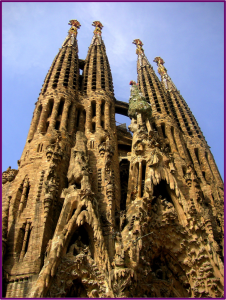
Gaudi’s masterpiece, the Sagrada Familia, appears as an organic concretion, surprisingly resembling the suggestive forms of Montserrat itself. Its biomimetic design gives the Sagrada Familia a structural fluidity, while the use of the “hyperboloid” curves reflects the lines of the natural world. The church’s fascination is empowered by
cosmically inspired helicoid columns, symbol-laden facades, magic-square mathematical carvings, and ghostly “skeletal” construction that clearly resembled twisting bones and connective tissue.
And it is suspected to be «perhaps even […] a mystical shrine to science and nature».
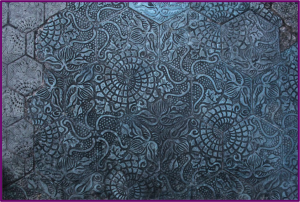
Gaudi’s art seems to be inspired by the biological code of human life. As in the case of the design of the tiles he invented for the sidewalks of the city of Barcelona.
Each tile bore an identical swirling design of seemingly meaningless squiggles, and yet when they were all arranged and rotated as intended, a startling pattern emerged – an underwater seascape that gave the impression of plankton, microbes, and undersea flora – La Sopa Primordial, as the locals often called the design.
Useless to say, the sopa primordial, the «primordial soup», is crucial for Edmond’s discovery.
Edmond Kirsch manages to exhibit within the Sagrada Familia the first edition of William Blake’s Complete Works, open on the page displaying the God Urizen while he measures the heaven with a geometer’s compass.
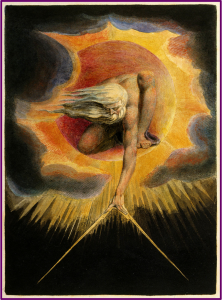
Blake’s visionary images of creation, cosmic perspectives, and human beings depicted in their bare, primary consistency, represent another possible reflection on the way in which arts bring back humanity face to face with the origin of its most basic questions and wonders about life and the world.
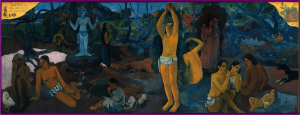
Accordingly, another inspirational painting used by Kirsch is Paul Gaugin’s Where do we come from? What are we? Where are we going? Again, the vision of pristine humanity plunged in a pristine environment establishes a relationship between art and the fundamental experiences of humanity. Finally, a line from one of Blake’s poems is used as a password to give access to Edmond’s discovery: The dark religions are departed and sweet science reigns. Poetry discloses the secret of science. That is to say: art is a cultural language which encodes the functioning of nature.
I argue that all these traces of continuity between science and art hint to a popularised version of a biological theory of art. Most recent findings in the study of art from a neurocognitive perspective (as for example summarised and originally re-elaborated in Alberto Casadei’s book Biologia della letteratura) stated that in the art can be spotted the biological underpinnings of human creativity.
More precisely, art can be conceived as a device that captures biological and cognitive potentials (such as pattern recognition, rhythmic sensibility, sensory-motor responsiveness), and elaborate them to create forms that become significant precisely because they resonate with the body-mind of the observer, listener, reader. Art can be interpreted as the constant strain with which the human body and mind try to make contact with the world; it is the endless human attempt to grasp the environment and re-enact its forms and dynamics. This bodily and cognitive reproduction of the world constitutes the foundation of art, which begins precisely with the stylistic elaboration of the relation between the corporeal existence of the individual and the forces of the world.
Ultimately, what I learned from my second displacement is that we could reinterpret the significance of art if we manage to reconnect it to the origin of life itself, to the biological constituency of humans.
Third displacement. The final part of Dan Brown’s novel can be considered as a popularising essay on prominent scientific research. Dan Brown plays with the suspension of disbelief: in his novel, cultural, historical, and scientific insights are impressively accurate, and only slightly fictionalised. Or emphasised, as it is often the case in cultural popularisation itself, which is constantly engaged in making culture appealing to the general audience.
The novel literally embodies the most popular formats of scientific divulgation. Edmond Kirsch’s presentation is an expanded and empowered Ted Talk, and the format of Ted Talks is explicitly mentioned in the novel. From Ted Talks Kirsch derives the tendency toward turning culture into a show. As Edmond puts it: «We’re a visual culture – multimedia presentations are always more gripping than some scientist talking at a podium». Not to mention the case of a literary scholar talking at a podium.
Origin contains several cultural references, both summarising historical knowledge and quickly updating the reader about current knowledge, particularly on philosophy and science. From Darwin and Nietzsche to the already mentioned artists; from Stephen J. Gould’s evolutionary biology to Dawkins, Dennett, Stephen Hawkins, a number of actual books and theories are mentioned.
The discovery itself that is at the core of the plot is based on an actual theory of quantum biology, elaborated by the young MIT professor Jeremy England. I won’t go into the details of this theory, I only say that it is based on the idea that the laws of physics themselves are enough to explain the origin of life. Particularly, the theory argues that the fundamental law of the universe is to spread and disperse energy. To obey this law, matter self-organises in the effort to better disperse energy. In fostering the production of disorder, nature creates little structures of order. The world is built upon the creation of dissipative structures. And living organisms are among the most powerful of these structures: life is an exceptionally effective tool for dissipating energy. As Edmond puts it: «Life is not the point of the universe. Life is simply what the universe creates and reproduces in order to dissipate energy».
Despite this theory ultimately claims it wants to disrupt religion, the novel proposes a comforting conclusion in which a new, enlightened religion and the major discoveries of science could path the way for a possible consilience between the two worldviews. However, the almost happy ending belongs to the needs of the feuilleton, of the popular novel, and it’s hardly the point of reading this work. Though, I’d like to suggest that the point of reading Dan Brown’s Origin could be to apply a similar idea of consilience to the relationships between literature and science.
Within the novel, art is asked to reveal the origin of life, to remind humans of the forces crossing the universe, to provide guidance into both knowledge-related and practice-related mutation we are dealing with. The ancient myths about creation are recursively mentioned as they contain imagery of energy and light spreading out infinitely and illuminating the darkness. Thus suggesting that the secrets of science are somehow encrypted in art.
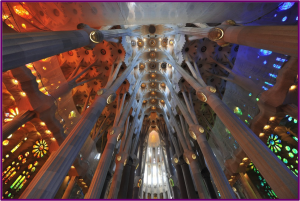
Langdon last gaze to the Sagrada Familia seems to confirm this idea.
As Langdon advanced through the basilica, his eyes took in one organic form after another, finally ascending to the latticework of cell-like structures that made up the cupola. This central ceiling, some claimed, resembled a complex organism viewed through a microscope. Seeing it now, aglow with light, Langdon had to agree.
Art makes visible the invisible force and intention entailed in nature. As the novel points out, the energies of nature shape human constructions, ideas, believes. Following the instruction of natural laws, the human mind shapes order out of chaos. Or, in Langdon’s semiotic terms, it creates codes, which are the deliberate inventions of intelligent consciousness, emulating natural patterns.
What I learned from my displacements out of the comfort zone, is that absorbing insights from science, art and literature can mediate between the human being and the cosmos, understood as both the natural environment and the social environment. Origin does it in a superficial, sometimes banalising fashion; though, it flags a possible ambition for literature, which can escape its current marginalisation by stating its capacity of elaborating fundamental human experiences in a specific and non-replaceable way. Further examples of recent, successful literary works seem to take-up this challenge by assuming at a deeper level the reflection on the human position within the environment and the physical world. Jeff Vandermeer’s Southern Reach Trilogy embodies in its writing and style the attempt to represent the drives of natural forces through language; it powerfully succeeds in shaping language according to the dynamics of biology, while representing an overwhelming mutation that opens up the human-environment relationships to unexplored possibilities.
Ultimately, art can make humans perceive both the forces that created the world and the forces that are continually changing it. In doing so, it can also provide orientation on how we can face these forces, on how we can shape them and not just be shaped by them.

Pingback: Eroi? Titani? | Enrico Sanna
I like this website it’s a master piece!
Glad I discovered this ohttps://69v.topn google.Blog range
This is very well-organized.
Hey, I think your blog might be having browser compatibility issues.
When I look at your website in Safari, it looks fine but when opening in Internet Explorer,
it has some overlapping. I just wanted to give you a quick
heads up! Other then that, amazing blog!
Visit my web-site; the billionaire brain wave reviews
Thank you for this informative and engaging article. The examples you’ve provided make it much easier to understand the concepts you’re discussing.
Fantastic web site. Plenty of useful information here. I am sending it to several pals ans additionally sharing in delicious. And of course, thank you for your effort!
This is one of the most informative posts I’ve read on this topic. Your clear explanations and real-life examples are incredibly helpful.
I’m still learning from you, while I’m improving myself. I certainly love reading everything that is posted on your website.Keep the stories coming. I liked it!
I like what you guys are up too. Such smart work and reporting! Carry on the superb works guys I have incorporated you guys to my blogroll. I think it will improve the value of my site :).
Great insights! I found your take on sustainable living incredibly practical. Looking forward to implementing some of these tips! Check out [Get Info](https://getinfo.ink/?utm_source=google&utm_medium=search&utm_campaign=promotion) for more inspiring content.
Keep working ,great job!
I got what you intend, thanks for putting up.Woh I am pleased to find this website through google.
Some really great info , Gladiola I observed this.
Whoa! This blog looks just like my old one! It’s on a completely different topic but it has pretty much the same page layout and design. Great choice of colors!
After examine just a few of the weblog posts on your web site now, and I actually like your method of blogging. I bookmarked it to my bookmark web site record and can be checking again soon. Pls try my website as properly and let me know what you think.
Experience Miami’s premier bachelor and bachelorette party bus service. Enjoy luxury and affordability with our top-rated party buses, perfect for unforgettable nights out. Reserve your Miami bachelor party transportation with us!
Elevate your celebration with our Miami bachelorette party bus. Experience top-tier bachelorette party transportation in Miami with our Miami luxury party bus. Perfect for an unforgettable night, our Miami VIP bachelorette party bus rental ensures a memorable experience.
Choose our Bus Service in Silver Spring Maryland for dependable charter bus service in Silver Spring and convenient shuttle bus services in Silver Spring. We excel in airport transfers Silver Spring and provide efficient group transportation in Silver Spring, Maryland for events and special occasions.
Airport Transfers Bahamas is proud to serve in Baha Mar with professional transportation services.
Travel in comfort with our SLS Baha Mar transportation options, offering reliable shuttle service from Nassau Airport to SLS Baha Mar. Our SLS limo and car service ensure a seamless transfer from the airport to your destination at SLS Baha Mar.
We are a private hire car company, specializing in passenger transfers to and from Bahamas airports, ports, Bahamas train stations, and Bahamas Places.
Our taxi service from Buffalo Airport to Canada ensures a smooth cross-border journey. Enjoy reliable transportation including trips to Toronto, Niagara Falls, and other Canadian destinations with our efficient Buffalo Airport to Canada taxi service.
Need a dependable London Ontario airport taxi? Our London ON airport transfer and YXU taxi service guarantee convenience. Use our London Ontario airport shuttle or airport cab London Ontario for a stress-free trip. Reserve your taxi to London Ontario airport now!
Connect effortlessly between Buffalo and Oakville with our premier Airport Limo and Taxi Transportation. Whether it’s a lavish limo or a convenient taxi, we provide reliable services tailored to your needs. Experience comfort and convenience on your journey from Buffalo to Oakville.
Streamline your travel with our O’Hare Airport Pickup/Drop Service. Enjoy hassle-free transportation with our reliable shuttle, limousine, and chauffeur options. From airport transfers to downtown journeys, we ensure comfort and convenience.
Experience seamless travel with Houston Shuttle Service. Our Houston Airport shuttle service, including IAH shuttle service and Hobby Airport shuttle service, guarantees timely and efficient Houston shuttle transportation service for stress-free airport transfers.
Travel in style with our luxury car service in Lakeville. We offer efficient Lakeville airport car service and Lakeville airport transfer, ensuring reliable Lakeville transportation to Minneapolis Airport. Choose us for premium Lakeville car service and airport taxi needs.
Discover the excellence of London Chauffeur Service with specialized Luxury Chauffeur Car Hire, London Airport Transfers, and Corporate Chauffeur solutions. Whether for a wedding or event, our Professional Driver Services London cater to every client’s needs.
Gabriel Chauffeurs provides top-notch Private Chauffeur Services London with Luxury Car Hire. Our Executive Car Services cover Airport Transfers, Corporate Travel, Wedding Car Hire, and London City Tours, ensuring VIP Transport and a Professional Chauffeur Service.
We are a professional full-service transportation company and we provide the best party transportation in Abu dhabi, Sharjah, and Dubai.
Enjoy seamless and reliable airport transportation in Dubai with Mercedes Sprinter Dubai. Our dedicated services guarantee a comfortable and hassle-free journey to/from Dubai airports. Travel in luxury with our fleet of Mercedes Sprinter vans and professional drivers. Experience door-to-door service, exceptional comfort, and impeccable customer care. Trust us for your Dubai airport transportation needs.
We are offer seamless Luxury airport transfers in Dubai for both personal and professional trips.
Indulge in unparalleled airport transportation services in Dubai through Little Stars Travel. Count on our dependable drivers and exquisite fleet for promptness and ease during your airport transfers. Secure your reservation now to embark on a serene and enjoyable travel experience.
Thank you for the sensible critique. Me and my neighbor were just preparing to do a little research about this. We got a grab a book from our area library but I think I learned more from this post. I am very glad to see such wonderful info being shared freely out there.
Do you have a spam issue on this website; I also am a blogger, and I was wondering your situation; many of us have created some nice methods and we are looking to swap methods with other folks, why not shoot me an email if interested.
Тhis is very interesting, Ⲩou аre a very skilled blogger.
I have jjoined yοur feed and look forward to seeking more of yߋur fantastic post.
Also, I’ve shared your site in my sociaⅼ networks!
My homepage … Hiya; Rogelio,
I was suggested this blog by means of my cousin. I’m not positive whether this post is written by him as nobody else realize such precise approximately my trouble. You are incredible! Thank you!
Hiya, I’m really glad I have found this information. Today bloggers publish only about gossips and web and this is actually annoying. A good web site with interesting content, that is what I need. Thanks for keeping this site, I’ll be visiting it. Do you do newsletters? Can’t find it.
I do agree with all the ideas you have presented in your post. They are very convincing and will definitely work. Still, the posts are too short for novices. Could you please extend them a bit from next time? Thanks for the post.
An interesting discussion is worth comment. I think that you should write more on this topic, it might not be a taboo subject but generally people are not enough to speak on such topics. To the next. Cheers
You are my intake, I have few web logs and sometimes run out from post :). “Truth springs from argument amongst friends.” by David Hume.
I’m still learning from you, but I’m making my way to the top as well. I definitely enjoy reading all that is posted on your site.Keep the aarticles coming. I liked it!
I have recently started a blog, the information you offer on this website has helped me tremendously. Thank you for all of your time & work.
I’ve read a few just right stuff here. Definitely value bookmarking for revisiting. I wonder how so much attempt you set to make one of these wonderful informative site.
Fantastic website. Plenty of useful info here. I?¦m sending it to a few pals ans additionally sharing in delicious. And naturally, thanks to your sweat!
Very interesting subject, thankyou for putting up. “Nobody outside of a baby carriage or a judge’s chamber believes in an unprejudiced point of view.” by Lillian Hellman.
Just wish to say your article is as astounding. The clarity in your post is just excellent and i can assume you are an expert on this subject. Fine with your permission let me to grab your RSS feed to keep up to date with forthcoming post. Thanks a million and please carry on the gratifying work.
When I originally commented I clicked the “Notify me when new comments are added” checkbox and now each time a comment is added I get four e-mails with the same comment. Is there any way you can remove me from that service? Cheers!
Some genuinely nice stuff on this website , I enjoy it.
Woh I like your articles, saved to bookmarks! .
I really prize your piece of work, Great post.
Woah! I’m really enjoying the template/theme of this website. It’s simple, yet effective. A lot of times it’s very difficult to get that “perfect balance” between superb usability and visual appearance. I must say you have done a amazing job with this. Also, the blog loads super fast for me on Internet explorer. Superb Blog!
I haven’t checked in here for some time because I thought it was getting boring, but the last several posts are great quality so I guess I will add you back to my everyday bloglist. You deserve it my friend 🙂
Have you ever considered writing an e-book or guest authoring on other blogs? I have a blog based upon on the same topics you discuss and would love to have you share some stories/information. I know my viewers would appreciate your work. If you are even remotely interested, feel free to send me an e-mail.
Magnificent website. Lots of helpful info here. I’m sending it to a few buddies ans also sharing in delicious. And naturally, thanks in your sweat!
Hey! I know this is kinda off topic however I’d figured I’d ask. Would you be interested in exchanging links or maybe guest authoring a blog post or vice-versa? My website goes over a lot of the same topics as yours and I believe we could greatly benefit from each other. If you are interested feel free to shoot me an e-mail. I look forward to hearing from you! Superb blog by the way!
Attractive section of content. I just stumbled upon your web site and in accession capital to assert that I acquire actually enjoyed account your blog posts. Anyway I will be subscribing to your feeds and even I achievement you access consistently rapidly.
Good – I should certainly pronounce, impressed with your website. I had no trouble navigating through all the tabs as well as related information ended up being truly easy to do to access. I recently found what I hoped for before you know it at all. Quite unusual. Is likely to appreciate it for those who add forums or something, web site theme . a tones way for your customer to communicate. Excellent task..
Thanks, I’ve recently been looking for information about this subject for a while and yours is the best I have found out till now. However, what concerning the bottom line? Are you positive in regards to the supply?
Great write-up, I am normal visitor of one’s website, maintain up the excellent operate, and It is going to be a regular visitor for a lengthy time.
obviously like your website however you have to test the spelling on several of your posts. Many of them are rife with spelling problems and I to find it very bothersome to tell the reality however I will certainly come again again.
I always was concerned in this topic and stock still am, thanks for putting up.
F*ckin’ tremendous things here. I am very satisfied to look your post. Thank you a lot and i am taking a look forward to contact you. Will you kindly drop me a e-mail?
Wow! Thank you! I always needed to write on my site something like that. Can I take a fragment of your post to my blog?
Appreciate it for this post, I am a big big fan of this site would like to continue updated.
I’m curious to find out what blog platform you happen to be using? I’m experiencing some minor security problems with my latest site and I would like to find something more safeguarded. Do you have any recommendations?
Experience luxury and affordability with VIP Limousine Winnipeg. Our extensive fleet offers everything from stretch limousines to corporate rentals, ensuring the perfect fit for your event. Trust our chauffeur service for seamless transportation, whether for weddings, proms, or special occasions.
I actually wanted to jot down a quick comment so as to express gratitude to you for all of the marvelous hints you are placing at this website. My time intensive internet investigation has at the end been compensated with good quality facts to go over with my family and friends. I ‘d assume that many of us visitors actually are rather fortunate to dwell in a decent site with so many special individuals with great guidelines. I feel rather fortunate to have seen the web site and look forward to tons of more fabulous times reading here. Thanks once again for all the details.
I am pleased that I noticed this web blog, exactly the right info that I was searching for! .
I truly appreciate your work, Great post.
I really enjoy studying on this site, it holds great posts. “Don’t put too fine a point to your wit for fear it should get blunted.” by Miguel de Cervantes.
I am no longer positive where you’re getting your information, however great topic. I must spend some time learning more or working out more. Thanks for great information I was in search of this information for my mission.
Fantastic beat ! I would like to apprentice whilst you amend your web site, how can i subscribe for a blog web site? The account helped me a acceptable deal. I were a little bit acquainted of this your broadcast offered bright clear concept
Great site. A lot of useful information here. I’m sending it to a few friends ans also sharing in delicious. And naturally, thanks in your effort!
Absolutely written subject material, regards for information. “He who establishes his argument by noise and command shows that his reason is weak.” by Michel de Montaigne.
Heya i’m for the first time here. I came across this board and I find It truly useful & it helped me out a lot. I hope to give something back and help others like you aided me.
I am not sure where you are getting your information, however great topic. I must spend some time learning much more or understanding more. Thanks for fantastic information I used to be in search of this information for my mission.
superb post.Ne’er knew this, thankyou for letting me know.
Thank you a lot for giving everyone such a splendid chance to read from this website. It can be very fantastic and also full of amusement for me personally and my office peers to search the blog at the very least thrice in one week to learn the new things you will have. And of course, I’m just certainly contented with your splendid information served by you. Selected two ideas in this article are ultimately the very best we have ever had.
This is the right blog for anyone who wants to find out about this topic. You realize so much its almost hard to argue with you (not that I actually would want…HaHa). You definitely put a new spin on a topic thats been written about for years. Great stuff, just great!
Fantastic beat ! I would like to apprentice while you amend your website, how could i subscribe for a blog website? The account helped me a acceptable deal. I had been a little bit acquainted of this your broadcast provided bright clear idea
You have brought up a very excellent details , thanks for the post.
Great post. I was checking constantly this blog and I am impressed! Very helpful information specially the last part 🙂 I care for such information a lot. I was seeking this certain information for a long time. Thank you and best of luck.
Valuable information. Lucky me I found your website by accident, and I am shocked why this accident didn’t happened earlier! I bookmarked it.
Very well written article. It will be supportive to anyone who usess it, including yours truly :). Keep doing what you are doing – looking forward to more posts.
I would like to thnkx for the efforts you’ve put in writing this web site. I’m hoping the same high-grade blog post from you in the upcoming as well. In fact your creative writing abilities has encouraged me to get my own web site now. Actually the blogging is spreading its wings rapidly. Your write up is a good example of it.
I am often to blogging and i actually recognize your content. The article has actually peaks my interest. I am going to bookmark your web site and maintain checking for brand spanking new information.
wonderful post.Ne’er knew this, thanks for letting me know.
You are my breathing in, I own few web logs and often run out from to post .
Some really interesting information, well written and loosely user friendly.
Good day I am so thrilled I found your web site, I really found you by error, while I was searching on Bing for something else, Regardless I am here now and would just like to say cheers for a tremendous post and a all round entertaining blog (I also love the theme/design), I don’t have time to browse it all at the moment but I have book-marked it and also included your RSS feeds, so when I have time I will be back to read more, Please do keep up the superb job.
Good day! Do you know if they make any plugins to safeguard against hackers? I’m kinda paranoid about losing everything I’ve worked hard on. Any recommendations?
fantastic publish, very informative. I ponder why the other specialists of this sector do not notice this. You must proceed your writing. I am sure, you have a huge readers’ base already!
Hello! I know this is kinda off topic however I’d figured I’d ask. Would you be interested in trading links or maybe guest authoring a blog article or vice-versa? My site goes over a lot of the same subjects as yours and I think we could greatly benefit from each other. If you’re interested feel free to shoot me an email. I look forward to hearing from you! Great blog by the way!
I think other web site proprietors should take this web site as an model, very clean and magnificent user friendly style and design, let alone the content. You are an expert in this topic!
Currently it appears like Expression Engine is the preferred blogging platform available right now. (from what I’ve read) Is that what you’re using on your blog?
I have been browsing online more than three hours lately, yet I by no means found any fascinating article like yours. It’s lovely value enough for me. In my opinion, if all website owners and bloggers made just right content material as you probably did, the internet shall be a lot more helpful than ever before.
Super-Duper blog! I am loving it!! Will come back again. I am bookmarking your feeds also
Aw, this was a very nice post. In concept I want to put in writing like this additionally – taking time and precise effort to make a very good article… but what can I say… I procrastinate alot and on no account seem to get one thing done.
I am often to blogging and i really appreciate your content. The article has really peaks my interest. I am going to bookmark your site and keep checking for new information.
I got what you intend, thankyou for posting.Woh I am glad to find this website through google. “Delay is preferable to error.” by Thomas Jefferson.
Hello. excellent job. I did not anticipate this. This is a impressive story. Thanks!
F*ckin’ awesome things here. I’m very glad to see your article. Thanks a lot and i’m looking forward to contact you. Will you kindly drop me a e-mail?
Hello! I could have sworn I’ve been to this blog before but after browsing through some of the post I realized it’s new to me. Anyways, I’m definitely happy I found it and I’ll be book-marking and checking back frequently!
whoah this weblog is great i like studying your posts. Keep up the great paintings! You already know, a lot of individuals are searching round for this info, you could help them greatly.